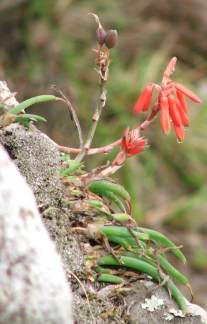Aloe challisii
Aloe challisii Van Jaarsv. & A.E.van Wyk
Family: Asphodelaceae
Common names: Steenkampsberg cliff aloe
Introduction
Aloe challisii is a charming new cliff-dwelling aloe from the Steenkampsberg in Mpumlanga Province. It is easily grown from cuttings and thrives as a pot plant.

Description
Description
Aloe challisii is a fast-growing dwarf succulent with fleshy roots and subterranean suckers, forming small, dense groups up to 200 mm in diameter. The branches at length hang down over cliff faces.
The leaves are rosulate (rosette forming), 4-7 per branch, soft, very fleshy, linear-triangular, about 100-200 mm long, 8-10 mm broad, curved downwards and pendent from rock faces, becoming channelled and less succulent during the dry season. The leaf surface is smooth, slightly pale bluish green and with white spots at the base. The leaf margins are minutely toothed (serrate), and slightly transparent, its teeth are soft and small and the leaf apex is pointed.
The inflorescence is a simple raceme 140-160 mm long, with up to 15 flowers crowded head-like in the terminal 40-45 mm of the inflorescence which at first bears orange buds. The flowers are tubular to slightly club-shaped and drooping, 25 mm long, bright orange-red, yellow and green-tipped. The petals (perianth segments) are free to the base. The stamens are yellowish and 20-22 mm long. The ovary is oblong, 5-6 mm long and 2 mm in diameter, grooved, brownish green with a 18 mm long style.
Its capsules are 16 mm long and 5 mm in diameter. The seeds are oblong, angular, 3-4 mm long, 1.5 mm broad and grey-black.
Flowering occurs mainly in spring (October).
Conservation Status
Status
Aloe challisii is a rare endemic confined to the Steenkampsberg near Lydenburg (Mpumalanga). However it is not threatened due to its safe cliff habitat.
Distribution and habitat
Distribution description
Aloe challisii is known only from the upper, vertical, quartzitic sandstone cliffs (south- and southeast-facing) along the southern part of the Steenkampsberg, southwest of Lydenburg in Mpumalanga Province, South Africa. It grows at an altitude of 1 700-1 800 m, frequently covered in clouds.

Plants occur scattered in rock crevices among moss and are difficult to reach. Rainfall is high, from 1 500-1 750 mm per annum, and is experienced mainly in summer. Vegetation of the region includes Afromontane grassland and forest in the kloofs. The new species was found in association with other temperate, high-altitude plants such as Morella pilulifera, Crassula pellucida subsp. brachypetala, C. setulosa var. setulosa, C. setulosa var. rubra, C. sarcocaulis, Elaphoglossum sp., Mohria caffrorum, Senecio orbicularis, Rhodohypoxis baurii, Ledebouria saundersiae and a species of Streptocarpus.
Seeds are dispersed by wind in the rainy season during the summer months (December onwards).
Derivation of name and historical aspects
History
The species is named for Mr Chris Challis, a Johannesburg businessman and lover of aloes and other succulents. He collected this species first while exploring a hiking trail at Verlorenkloof on the Steenkampsberg. It was described by Braam van Wyk and the author in 2006 (Van Jaarsveld & Van Wyk 2006).

Some 125 species of Aloe are indigenous to South Africa and Namibia (Glen & Smith 2003). Aloe challisii is the seventeenth species of Aloe (21% of the total) and the fourth member of section Leptoaloe, a group of small aloes growing in cool mountainous grassland habitat (Reynolds 1950), recorded as confined to sheer cliff faces in South Africa and Namibia. This section also includes A. nubigena, A. thompsoniae and A. soutpansbergensis, all of them with soft, flaccid leaves bearing small or no (Aloe nubigena) marginal teeth. Aloe nubigena and A. soutpansbergensis also have a pendent habit. A. challisii is at once distinguished from the other cliff-dwelling species by its short inflorescence bearing its flowers in an almost head-like (subcapitate) inflorescence, and with a flower perianth which is almost club-shaped (subclavate). The species is further distinguished by its bluish green, almost cylindric (subterete) leaves. Its closest known relative is A. soutpansbergensis, which has longer cylindrical flowers which appear during summer (not spring), and flat, channelled leaves which are less markedly succulent.
Ecology
Ecology
Aloe challisii is pollinated by sunbirds.
Uses
Use
No uses, other than the horticultural potential, have been recorded.
Growing Aloe challisii
Grow
Propagation
Aloe challisii is easily grown and can be propagated by seed or by offshoots. The best time for sowing the seeds is in spring or summer. They are best sown in a sandy, well-drained potting soil in a warm shady position in standard seed trays. Cover the seeds with a thin layer of sand (1-2 mm) and keep moist. Germination will take place within 3 weeks and the seedlings grow fast. They can be planted out in individual bags or containers as soon as they are large enough to handle. Keep in a cool situation and provide sufficient moisture. Offshoots can be removed with a sharp knife and transplanted or first rooted in sand. It is recommended to add a fungicide when watering. The plants grow fast and can reach flowering stage in about 2-3 years.
Cultivation
Aloe challisii grows best in containers or hanging baskets. It should preferably be grown in partial shade. Plants proliferate readily and soon become pendent. They are not shy of flowering. The key to successfully growing this species is a sandy acid soil with excellent drainage, cool moist conditions during summer and dry winters. It is frost resistant and fairly pest-free, but will rapidly rot if there is insufficient drainage. Aloe challisii responds well to fertilisers, and an organic feeding is recommended during spring and summer.
References
- Glen, H.F. & Smith, G.F. 2003. Aloe. In G. Germishuizen & N.L.Meyer, Plants of southern Africa : an annotated checklist. Strelitzia 14: 978-988. National Botanical Institute, Pretoria.
- Reynolds, G.W. 1950. The aloes of South Africa. A.A. Balkema, Cape Town, Rotterdam.
- Van Jaarsveld, E.J. & Van Wyk, A.E. 2006. Aloe challisii, a new cliff-dwelling aloe from Mpumalanga, and a checklist of the obligate cliff-dwelling aloes in South Africa and Namibia. Aloe 43, 2 & 3: 36-39.
- Van Wyk, B-E., & Smith, G.D. 1996. Guide to the aloes of South Africa. Briza, Pretoria.
Credits
Ernst van Jaarsveld
Kirstenbosch National Botanical Garden
October 2007
Plant Attributes:
Plant Type: Succulent
SA Distribution: Mpumalanga
Soil type: Loam
Flowering season: Spring
PH: Acid
Flower colour: Orange
Aspect: Full Sun, Shade, Morning Sun (Semi Shade)
Gardening skill: Average
Special Features:
Horticultural zones







Rate this article
Article well written and informative
Rate this plant
Is this an interesting plant?
Login to add your Comment
Back to topNot registered yet? Click here to register.